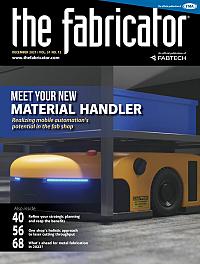Managing Director
- FMA
- The Fabricator
- FABTECH
- Canadian Metalworking
Categories
- Additive Manufacturing
- Aluminum Welding
- Arc Welding
- Assembly and Joining
- Automation and Robotics
- Bending and Forming
- Consumables
- Cutting and Weld Prep
- Electric Vehicles
- En Español
- Finishing
- Hydroforming
- Laser Cutting
- Laser Welding
- Machining
- Manufacturing Software
- Materials Handling
- Metals/Materials
- Oxyfuel Cutting
- Plasma Cutting
- Power Tools
- Punching and Other Holemaking
- Roll Forming
- Safety
- Sawing
- Shearing
- Shop Management
- Testing and Measuring
- Tube and Pipe Fabrication
- Tube and Pipe Production
- Waterjet Cutting
Industry Directory
Webcasts
Podcasts
FAB 40
Advertise
Subscribe
Account Login
Search
Improving laser job shop quote accuracy through better communication
3 tips to combat miscommunication about laser cutting work with customers
- By Ivan Cooper
- December 13, 2021
- Article
- Manufacturing Software

As lasers cut a swath from science fiction to IIoT reality, the three R’s of customer communication—records, references, and rules—are key to making them work for your business. Getty Images
Laser cutting of metals and materials is a game-changer across multiple industries. The technology offers fabricators opportunities to respond flexibly to the digital revolution of Industry 4.0 and the Industrial Internet of Things (IIoT).
This extremely accurate technology (with IIoT sensors offering near-zero tolerances) is fast, labor-saving, and energy-efficient. Lasers have moved from 1960s fantasy to a world-beating reality since the evil Goldfinger prepared to slice up James Bond with a hissing beam of light, and intergalactic heroes and villains fought with laser swords and deadly beams of incandescent light for the future of humanity.
The down-to-earth reality in the world of industry is different, but better for productivity. Even common industrial laser systems today (≥1 kW) will now cut carbon steel from 0.51 to 13 mm thick. And the technology is moving ahead in leaps and bounds as demanding industries—like automotive, aviation, manufacturing, mining and energy, and shipbuilding—use it to produce intricate products and parts more quickly and precisely than ever before.
But good laser cutting technology is not enough by itself. Top cutting technology must be coupled with top customer service technology to make sure customers get exactly what they want.
Less Time and Waste: May I Quote You?
The ongoing trend toward automation in laser cutting output places further importance on an accurate quotation system in which the input parameters are clearly defined and agreed upon, so powerful customer communication must be built into the input process before a single piece of material is cut.
It is easy to believe the actual cutting equipment—the laser machine itself—is by far the most critical component in developing a business based on this technology. But a huge part of the job of laser cutting, for cutters and customers alike, is ensuring that the quotation system is tailored to the needs of the customer, to make the specifying of the job easier for them and cutting out wasted time and mistakes through intelligent software.
To ensure the quoted output is right, you have to ensure the input quote is right—and understood by all parties before production starts.
Achieving Powerful Customer Communications: The Three R’s
Most issues that arise in a job shop can be linked to miscommunication during the very first interaction with a customer and the request for quote (RFQ). Common errors result from an incomplete source drawing, incorrect interpretation of the process layers in the source drawing, and duplicate data in part names or part IDs. And those errors make customers unhappy, because they can’t rely on you to deliver exactly what they expected, and we all know what happens next.
One way to prevent miscommunication and thus improve your customers’ experience is to have a system in place that addresses the three R’s:
- Records. Maintaining a record of each communication with a customer about its RFQ and requirements ensures compliance to quality systems and reduces the cost of quality.
- References. Digital thumbnail references in a quote line item with X and Y reference measurements ensure that, visually, the part and scaling are correct.
- Rules. Implementing system rules to calculate part prices ensures accurate and consistent quotes, regardless of who prepares the RFQ.
Ideally, an effective recording system combined with visual references and a rules-based sales system allows your sales staff to understand your customers and their needs and to deliver a consistent experience.

As lasers move from science fiction to science fact, down-to-earth communication practicalities are key to customer satisfaction to help businesses grow.
Records: Who Said What?
An effective system should allow you to keep a record of every customer and their RFQs and orders. Being able to access the critical customer service information in an interactive record system enables your staff to clarify any uncertainty and eliminate any inconvenience for the customer promptly.
If a customer queries a quote, the job shop has the ability to readily retrieve that quote; understand the circumstances while talking to the customer on the phone; look at each line item and the visual parts; and then, if needed, tweak the quote and recalculate the quote in seconds. This ensures that your shop is resolving any issues immediately. The time-saving component here is huge.
References: Does This Look Right?
Simply adding a visual reference in the form of a digital thumbnail of each part in a customer’s quotation could end up saving you thousands of dollars. Providing a visual of each quoted part gives your customer an additional opportunity to confirm that the part is in fact what they want.
A typical example here could be the transposition of a part ID number in an RFQ. Having the visual ensures that the customer can more easily identify a shape error of that part. Including X and Y dimensions with the visual also can help ensure scaling issues are addressed.
Rules: Is This the Same Price as Last Time?
Predefined system rules, established and controlled by your business, can help reduce error rates and eliminate time spent manually looking for data such as customer reference records, material price, and feed rates.
This also means that no matter who does the quoting in the business, the price should never vary if quoted on the same day by two different estimators. A balanced and controlled set of sales rules, with management controlling the key data required to calculate an RFQ, maintains pricing consistency regardless of who attends to the customer.
Facilitating Communication With Technology
To complement these techniques for improving communication, cloud-based platforms are available that can help busy, modern laser job shops produce accurate, consistent, and timely quotations for complex parts requiring multiple processes.
With this type of software, which can automatically process 3D engineering and production graphics provided by customers, laser job shops can shorten quote turnaround times to minutes or hours instead of one or more days, and administrator-controlled rules help ensure consistent, quantity-based pricing.
About the Author
Ivan Cooper
Suite 1 10-12 Chapel St.
Blackburn, Victoria, 3130 Australia
subscribe now

The Fabricator is North America's leading magazine for the metal forming and fabricating industry. The magazine delivers the news, technical articles, and case histories that enable fabricators to do their jobs more efficiently. The Fabricator has served the industry since 1970.
start your free subscription- Stay connected from anywhere

Easily access valuable industry resources now with full access to the digital edition of The Fabricator.

Easily access valuable industry resources now with full access to the digital edition of The Welder.

Easily access valuable industry resources now with full access to the digital edition of The Tube and Pipe Journal.
- Podcasting
- Podcast:
- The Fabricator Podcast
- Published:
- 04/16/2024
- Running Time:
- 63:29
In this episode of The Fabricator Podcast, Caleb Chamberlain, co-founder and CEO of OSH Cut, discusses his company’s...
- Trending Articles
AI, machine learning, and the future of metal fabrication

Employee ownership: The best way to ensure engagement

Steel industry reacts to Nucor’s new weekly published HRC price

Dynamic Metal blossoms with each passing year

Metal fabrication management: A guide for new supervisors

- Industry Events
16th Annual Safety Conference
- April 30 - May 1, 2024
- Elgin,
Pipe and Tube Conference
- May 21 - 22, 2024
- Omaha, NE
World-Class Roll Forming Workshop
- June 5 - 6, 2024
- Louisville, KY
Advanced Laser Application Workshop
- June 25 - 27, 2024
- Novi, MI



























